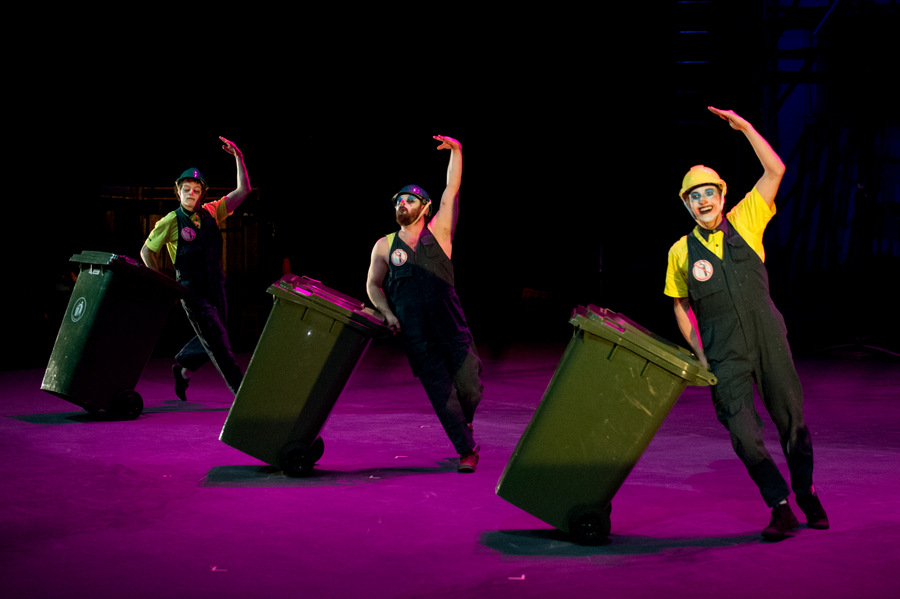- Lucy and the lost boy: NICA
In mid-June I attended a performance by graduating students of the National Institute of Circus Arts (NICA) in Melbourne. Their show, Lucy and the lost boy, was devised and directed by Sally Richardson and I was pleased to see the two NICA students I had interviewed for the Heath Ledger Project, Josie Wardrope and Simon Reynolds, taking major roles in the show. In fact the ‘Lucy’ of the show’s title was Josie Wardrope. Wardrope’s performance on flying trapeze in the closing scene was thrilling, while the variety of skills at which Simon Reynolds excels is remarkable.
It was, in addition, a pleasure to see other talented students from the graduating year in the show. I especially enjoyed the performance of Skip Walker-Milne, who took the role of the Lost Boy. He was a strong performer and I hope to follow his career in the future. But from a dance perspective I got particular pleasure from a vignette by three clowns, Jamie Bretman, Jack Coleman and Simon Wright, who were named in the show as ‘The Clown Kings’. While they had a role throughout the show, including amusing the people standing in the queue to get into the auditorium, I especially loved a sequence in which they performed to the ‘Little Swans’ music from Swan Lake.

Meredith Kitchen was named as choreographer for the show, so I assume their performance was her doing. I have long been fascinated by the place the ‘Little Swans’ dance has beyond the strict confines of a classical production of Swan Lake. These Clown Kings, with their roller bins, their deliciously clumsy coupé steps, and their innocent expressions, gave me huge pleasure.
- Reviews from The Canberra Times
In June my reviews of The Nutcracker on Ice: the Imperial Ice Stars and Sydney Dance Company’s The Land of Yes & The Land of No were published by The Canberra Times.
I continue to be impressed by Rafael Bonachela’s choreography and the remarkable performances the dancers of Sydney Dance Company give.
- Oral history: James Mollison, AO
Also in June I also had the pleasure of recording an oral history interview with James Mollison, whose many achievements include his role as inaugural director of the National Gallery of Australia in Canberra. Mollison was also responsible for acquiring the major portion of the Diaghilev costume collection, of which the Gallery is the envied owner. ‘Why does Canberra have those costumes?’ I have often been asked by people in the northern hemisphere. My reply has always been, ‘It’s because Canberra had a forward-thinking inaugural director of the National Gallery.’ The collection has formed the basis of three exhibitions by the National Gallery of Australia, most recently in 2010-2011.
- The Australian Ballet in New York
The question of the New York reviews for the Australian Ballet’s recent visit to Manhattan has been discussed briefly amid comments on the Romeo and Juliet post on this site. Another review that I found especially interesting came from Ryan Wenzel on his website ‘Bodies never lie’. Wenzel appears to have reviewed only the mixed bill, at least at this stage, but his comments on repertoire are worth considering. He writes, for example: ‘The choreography too rarely stretched the mind, entertained, or provided innovative commentary on ballet as an art form’.
Michelle Potter, 30 June 2012
Hi Michelle,
Thanks for mentioning my blog. I was able to catch only the mixed bill because of a trip I had planned.
I’m sure you have a sense of this from reading my blog, but when it comes to dancing, I’m most interested in choreography. I hope this came through in my review, but I left that mixed bill feeling disappointed that the Australian dancers weren’t given better works to show their talents.
Yes, your focus on and interest in choreography came through, which is the main reason that I provided my readers with a link. I absolutely agree that dancers need something to dance. I also think that being seen outside the comfort of one’s home country, and receiving well-considered reviews from those who don’t know the company the way we do in Australia, is only to everyone’s benefit. In my opinion in Australia there is too little critical comment on and discussion of the Australian Ballet’s repertoire and performances and too much focus on ‘bling’ (for want of a better word). So thank you, Ryan, for commenting.